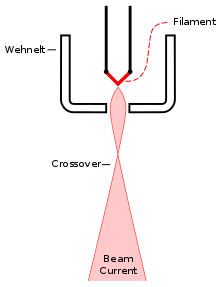36:
133:
213:. An electron emitter is positioned directly above the Wehnelt aperture, and an anode is located below the Wehnelt. The anode is biased to a high positive voltage (typically +1 kV to +30 kV) relative to the emitter so as to accelerate electrons from the emitter towards the anode, thus creating an electron beam that passes through the Wehnelt aperture.
243:
The
Wehnelt bias controls beam focusing as well as the effective size of the electron source, which is essential for creating an electron beam that is to be focussed into a very small spot (for scanning electron microscopy) or a very parallel beam (for diffraction). Although a smaller source can be
239:
As the
Wehnelt's negative bias voltage increases, the tip's emitting area (and along with it, the beam diameter and beam current) will decrease until it becomes so small that the beam is "pinched" off. In normal operation, the bias is typically set slightly more positive than the pinch bias, and
235:
The emitter tip is positioned near the
Wehnelt aperture so that, when appropriate bias voltage is applied to the Wehnelt, a small region of the tip has a net electric field (due to both anode attraction and Wehnelt repulsion) that allows emission from only that area of the tip. The Wehnelt bias
196:
A Wehnelt cap has the shape of a topless, hollow cylinder. The bottom side of the cylinder has an aperture (through hole) located at its center, with a diameter that typically ranges from 200 to 1200 μm. The bottom face of the cylinder is often made from platinum or tantalum foil.
232:
with a V-shaped (or otherwise pointed) tip. This bias voltage creates a repulsive electrostatic field that suppresses emission of electrons from most areas of the cathode.
236:
voltage determines the tip's emission area, which in turn determines both the beam current and effective size of the beam's electron source.
100:
137:
72:
180:, a German physicist, who invented it during the years 1902 and 1903. Wehnelt cylinders are found in the electron guns of
79:
119:
53:
216:
The
Wehnelt is biased to a negative voltage (typically −200V to −300V) relative to the emitter, which is usually a
86:
140:
view, showing how a
Wehnelt localizes emissions at the filament tip and serves as a convergent electrostatic lens
57:
68:
244:
imaged to a smaller spot, or a more parallel beam, one obvious trade off is a smaller total beam current.
46:
17:
93:
302:
270:
221:
8:
307:
185:
169:
274:
210:
282:
278:
261:
Fleming, Ambrose (1934). "On the history and development of the thermionic valve".
181:
188:, and in other applications where a thin, well-focused electron beam is required.
177:
296:
173:
206:
165:
229:
240:
determined by a balance between desired beam quality and beam current.
161:
35:
217:
27:
Electrode in the electron gun assembly of some thermionic devices
132:
60:. Unsourced material may be challenged and removed.
294:
172:devices, used for focusing and control of the
120:Learn how and when to remove this message
131:
260:
14:
295:
58:adding citations to reliable sources
29:
209:and it also serves as a convergent
24:
25:
319:
263:Journal of Scientific Instruments
34:
178:Arthur Rudolph Berthold Wehnelt
45:needs additional citations for
254:
13:
1:
247:
200:
191:
7:
10:
324:
283:10.1088/0950-7671/11/2/303
141:
135:
222:Lanthanum hexaboride
205:A Wehnelt acts as a
186:electron microscopes
176:. It is named after
54:improve this article
275:1934JScI...11...44F
211:electrostatic lens
142:
69:"Wehnelt cylinder"
182:cathode ray tubes
168:assembly of some
130:
129:
122:
104:
16:(Redirected from
315:
287:
286:
258:
146:Wehnelt cylinder
125:
118:
114:
111:
105:
103:
62:
38:
30:
21:
323:
322:
318:
317:
316:
314:
313:
312:
293:
292:
291:
290:
259:
255:
250:
227:
203:
194:
148:(also known as
126:
115:
109:
106:
63:
61:
51:
39:
28:
23:
22:
15:
12:
11:
5:
321:
311:
310:
305:
289:
288:
252:
251:
249:
246:
225:
202:
199:
193:
190:
128:
127:
42:
40:
33:
26:
9:
6:
4:
3:
2:
320:
309:
306:
304:
301:
300:
298:
284:
280:
276:
272:
268:
264:
257:
253:
245:
241:
237:
233:
231:
223:
219:
214:
212:
208:
198:
189:
187:
183:
179:
175:
174:electron beam
171:
167:
163:
159:
155:
151:
147:
139:
138:cross-section
134:
124:
121:
113:
102:
99:
95:
92:
88:
85:
81:
78:
74:
71: –
70:
66:
65:Find sources:
59:
55:
49:
48:
43:This article
41:
37:
32:
31:
19:
303:Vacuum tubes
269:(2): 44–49.
266:
262:
256:
242:
238:
234:
220:filament or
215:
207:control grid
204:
195:
166:electron gun
157:
153:
149:
145:
143:
116:
107:
97:
90:
83:
76:
64:
52:Please help
47:verification
44:
230:hot cathode
150:Wehnelt cap
308:Electrodes
297:Categories
248:References
170:thermionic
156:or simply
80:newspapers
201:Operation
192:Structure
162:electrode
110:July 2020
218:tungsten
160:) is an
154:grid cap
271:Bibcode
164:in the
158:Wehnelt
94:scholar
18:Wehnelt
96:
89:
82:
75:
67:
101:JSTOR
87:books
224:(LaB
184:and
73:news
279:doi
56:by
299::
277:.
267:11
265:.
228:)
152:,
144:A
136:A
285:.
281::
273::
226:6
123:)
117:(
112:)
108:(
98:·
91:·
84:·
77:·
50:.
20:)
Text is available under the Creative Commons Attribution-ShareAlike License. Additional terms may apply.
